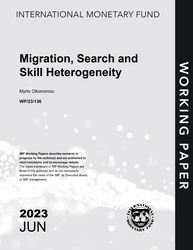
Migration, Search and Skill Heterogeneity
Migration, Search and Skill Heterogeneity
READ MORE...
Volume/Issue:
Volume 2023
Issue 136
Publication date: June 2023
ISBN: 9798400247927
$20.00
Add to Cart by clicking price of the language and format you'd like to purchase
Available Languages and Formats
| English |
Prices in red indicate formats that are not yet available but are forthcoming.
Topics covered in this book
This title contains information about the following subjects.
Click on a subject if you would like to see other titles with the same subjects.
Labor , Economics- Macroeconomics , Economics / General , Emigration and Immigration , Migration , Matching Frictions , Skill Heterogeneity , emigration flow , cross-border migration , net emigration , risk-premium shock , Labor markets , Labor market frictions , Skilled labor , Labor mobility , Southern Europe
Summary
Cross-border migration can act as an important adjustment mechanism to country-specific shocks. Yet, depending on who moves, it can have unintended consequences for business cycle stability. This paper argues that the skill composition of migration plays a critical role. When migration flows become more concentrated in skilled labor an important trade-off arises. On the one hand, migration releases unemployment pressures for the origin countries. On the other hand, it generates negative compositional effects (the so-called “brain drain” effects) and skill imbalances, which reduce supply capacity in origin countries. This paper analyses quantitatively the impact of cyclical migration in an open-economy Dynamic Stochastic General Equilibrium (DSGE) model with endogenous migration flows, trade linkages, search and matching frictions, and skill heterogeneity. I apply this framework to the case of the Greek emigration wave following the European Debt Crisis. What I find is that emigration flows implied strong negative effects for capital formation, leading to more than a 15 percentage point drop in investment. Rather than stabilizing the Greek business cycle, labor mobility led to a deeper and more protracted recession.
Copyright © 2010 - 2025
Powered by:
AIDC



